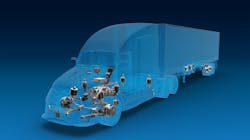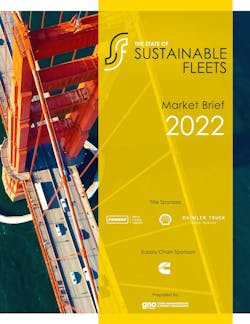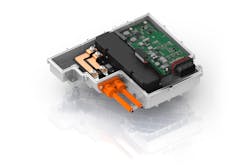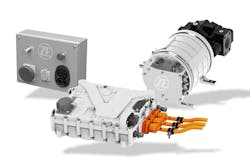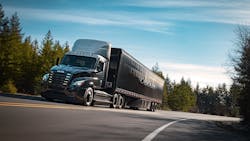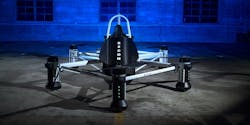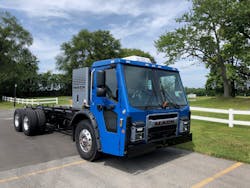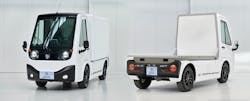ACT Expo 2022 Highlights Advancements in Electric Vehicle Technology
*Editor's Note: This article was originally published May 9 and updated May 11 with additional information.
Each year the Advanced Clean Transportation (ACT) Expo provides a look at the latest technological developments in electric vehicle (EV) and other emissions-reducing solutions. Aimed at fleets in the transportation industry, exhibits and conference sessions cover a variety topics from currently available technologies to best practices for implementing them.
Keynote speakers at the 2022 event, taking place May 9-12, include representatives from companies working on various alternative energy technologies such as Cummins, Navistar and Daimler Trucks North America.
Advancements being made in batteries, fuel cells, and other alternative energy systems are among the many news and technology highlights at this year's event, as well as commercially available or soon to be released alternatively powered vehicles.
State of Sustainable Fleets Report Shows Continued Growth of Low- and Zero-Emissions Vehicles
Gladstein, Neandross & Associates (GNA), which organizes the ACT Expo, is a clean technology consulting firm; it released the findings of its third annual State of Sustainable Fleets Market Brief during the event.
"We are seeing an incredible acceleration in the investment being made from all sides of the alternative fuel vehicle market driven by increasing commitments to environmental sustainability and carbon reduction and to find more cost-effective transportation options given today's record-breaking gasoline and diesel fuel prices," said Erik Neandross, CEO of GNA, in the firm's press release announcing the debut of the report. "Again, our survey results confirm — in every sector, fleets are increasingly turning to a spectrum of advanced clean vehicle technologies and low carbon fuels to not only meet their sustainability goals but improve their fleet's bottom line."As transportation fleets and other sectors continue moving toward electrification and other technologies, there will be impacts on traditional components and systems such as hydraulics and pneumatics, making reports like this an informative asset for many manufacturers serving transportation applications.
Close to 250 U.S.-based fleets using clean technologies were surveyed. Of those, almost 85% said use of clean vehicle technologies will grow over the next 5 years says GNA in its press release.
More availability of fueling and charging infrastructure as well as funding from state and federal government authorities has lead to increased adoption of alternative fuels, electrification and other technologies.
Among key findings in the report are (as stated in GNA's press release):
- Battery-electric vehicle demand is ramping up despite supply chain delays and high costs. The report finds that scheduled medium- and heavy-duty battery-electric vehicle deployments will go from dozens to hundreds across this year and next. Fleets are placing record-setting orders and certain sectors are already seeing early scale including nearly 1,800 battery-electric school buses ordered or deployed by more than 350 school fleets in the U.S. to date. A few hundred more grant-funded Class 8 battery-electric vehicle orders from major manufacturers were placed in 2021 and early 2022. Orders still far out-pace vehicle deliveries and battery prices remain stubbornly high. An emerging trend in this space — vehicle manufacturers are becoming more involved in the battery-electric ecosystem by providing value-add services to fleets learning to operate in this new and unfamiliar space.
- Hydrogen vehicles are on the horizon with larger grant-funded demonstrations beginning now. The report found that total hydrogen heavy-duty vehicle purchases in the U.S. were just under 150 orders in 2021. There were no public hydrogen stations opened outside of California in 2021, but an additional 57 stations, primarily for light- duty hydrogen vehicles, are planned for California, Ohio, New York, Rhode Island, Connecticut, and Massachusetts. Dozens of grant-funded fuel cell electric tractors are now on order by leading fleets.
ZF Expands In-House Capabilities for Electric Powertrain Components
Component manufacturer ZF continues to invest in its technology offering for electric vehicles of various types. As such, the company is introducing a modular and scalable silicon carbide (SiC) inverter architecture, hairpin electric motor, and electric powertrain and accessories—known as eWorX—to its offering for commercial vehicles.ZF says its inverter is based on the latest silicon carbide technologies and is designed to offer flexibility to users. Its architecture includes next-generation power semiconductors and highly intelligent software algorithms the company says in its press release announcing availability of these new EV components.
The new eWorX portfolio includes fully electric system solutions in a compact design says ZF; they include standard interfaces to help simplify integration for vehicle OEMs no matter the driveline configuration.
Meritor Launches Power Control and Accessory System
Meritor Inc. announced the production launch of the fourth generation of its Power Control and Accessory System (PCAS). Designed for use in zero-emissions commercial vehicles, the PCAS provides power as needed and control over sub-systems and accessories.
It is installed in the space where an engine would typically be located, easing integration for OEMs.
The PCAS allows tuning of the entire electric drivetrain to help ensure performance, efficiency and range. According to Meritor's press release announcing the system's production launch, it enables:
- On-demand electric accessories performance management
- Thermal management
- Performance optimization through single pedal driving
- Torque path management
- Charging management during sleep mode.
Freightliner Debuts New Battery-Electric eCascadia
Freightliner Trucks, unveiled its latest eCascadia battery-electric Class 8 truck during ACT Expo. The new electric truck model is the result of extensive development and rigorous testing, the company says in its press release announcing the truck's launch.
Freightliner went through several prototypes of the truck as well as testing with customers to ensure the final result would be something that meets their needs.
The new eCascadia is available with multiple battery and drive axle options. It can provide a driving range of 230 miles, depending on the vehicle configuration. Freightliner says the truck is best suited for short-haul routes with depot charging such as last-mile logistics and distribution.
Features of the new eCascadia per Freightliner's press release include:
- 320-470 hp
- Multiple battery options and maximum capacity of almost 440 kWh
- Recharge of 80% in approximately 90 minutes
- Up to 82,000 lbs. max GCW (Gross Combination Weight)
- Available with single or tandem eAxle
- 116 in. day cab configuration
Learn more about the new eCascadia from our colleagues at FleetOwner.
RYSE Debuts Electric Vertical Takeoff and Landing Platform
RYSE Aero Technologies is introducing its first electric vertical takeoff and landing (eVTOL) platform, the RYSE RECON, at ACT Expo. The eVTOL features a removable battery and operation systems which not only power the vehicle but allow for the device to be configured to meet customers' specific application needs.
Advanced artificial intelligence and a simple control system make the eVTOL easy to use no matter what a person's experience level may be.
The company says its battery packs are designed to be similar to other commonly used batteries so they can be easily removed and recharged as needed, and spares can be kept on hand.
RYSE is looking to bring the RYSE RECON to markets which may not have previously considered use of such a tool such as agronomy, land surveying, vineyards and more.
Mack Trucks Features Battery-Powered LR Electric Refuse Vehicle
Mack Trucks is one of many truck OEMs exhibiting its electric vehicle designs during ACT Expo. The company is showing its Class 8 Mack LR Electric refuse model which provides a zero-emissions option for refuse and recycling collection.
According to the company, it's next generation LR Electric provides 42% more energy. It is powered by a battery with a total capacity of 376 kWh which enables an extended range between charges. Two 448 hp electric motors help drive the vehicle and provide 4,051 lb.-ft. of torque from 0 rpm.
A total of four NMC (Nickel Manganese Cobalt Oxide) lithium-ion batteries are used to power the refuse vehicle. A two-stage regenerative braking system helps keep the battery charged by collecting energy during the vehicle's many start and stop cycles.
GreenPower Exhibits Three EVs
Manufacturer of electric-powered vehicles GreenPower Motor Co. Inc. is exhibiting three of its electric vehicles serving various transportation applications.
Per the company's press release announcing its presence at ACT Expo, these vehicles include:
- BEAST (Electric School Bus)
- The BEAST stands for battery electric automotive school transportation. It is an all-electric, zero-noise pollution school bus. It features a Monocoque chassis and has been designed from the ground up to be battery electric.
- EV Star (Side ADA)
- The EV Star is a multi-purpose, zero-emission, min-E Bus. It has a range of up to 150 miles and offers dual charging capabilities as a standard feature. The EV Star can be used for para-transit, employee shuttles, micro-transit, and vanpool service.
- EV Star Cargo
- The EV Star Cargo is a class-4 vehicle for last-mile delivery solutions with a capacity of up to 5,000 pounds and 150-mile range. The EV Star Cargo was made to be a delivery solutions vehicle and can take on the most challenging routes.
Tropos Motors Debuts ABLE NXT Electric Truck Platform
Tropos Motors, a designer and builder of fully electric compact utility vehicles, is set to launch its ABLE NXT vehicle platform. The vehicle features a modular structure which enables customers to quickly change the vehicle's cargo options, benefiting its use in a range of applications including last-mile delivery, facility maintenance, warehousing and more.
The truck is 100% electric and features:
- up to 33 kWh lithium battery pack
- ultra-high efficiency electric drivetrain providing over 5 miles per kilowatt of energy
- advanced fleet telematics
The company says it sources its components from manufacturers in the European Union, better enabling it to control its supply chain and ensure the quality of products it utilizes. The vehicles are then assembled in the U.S. for customers there.
About the Author
Sara Jensen
Executive Editor, Power & Motion
Sara Jensen is executive editor of Power & Motion, directing expanded coverage into the modern fluid power space, as well as mechatronic and smart technologies. She has over 15 years of publishing experience. Prior to Power & Motion she spent 11 years with a trade publication for engineers of heavy-duty equipment, the last 3 of which were as the editor and brand lead. Over the course of her time in the B2B industry, Sara has gained an extensive knowledge of various heavy-duty equipment industries — including construction, agriculture, mining and on-road trucks —along with the systems and market trends which impact them such as fluid power and electronic motion control technologies.
You can follow Sara and Power & Motion via the following social media handles:
X (formerly Twitter): @TechnlgyEditor and @PowerMotionTech
LinkedIn: @SaraJensen and @Power&Motion
Facebook: @PowerMotionTech

Leaders relevant to this article:
